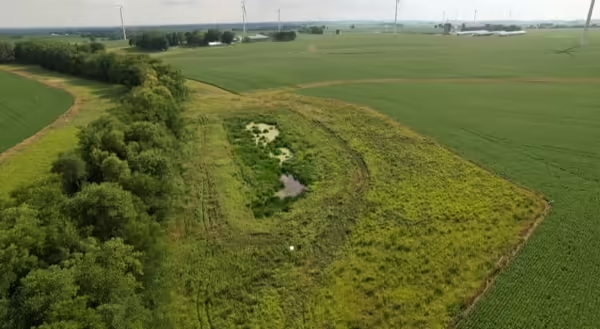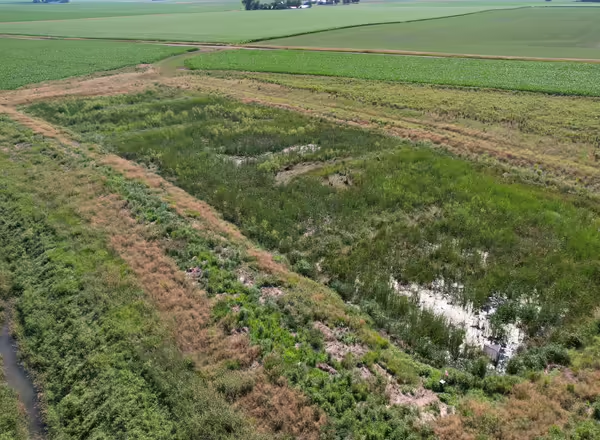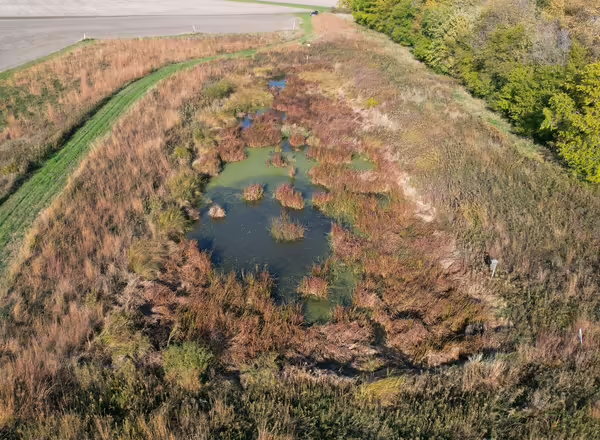
Farmers in Bureau and Marshall Counties are turning to an innovative conservation practice that’s not only helping the environment — but also potentially boosting their bottom line. Constructed wetlands, designed to treat water from subsurface tile drainage, are gaining traction as a way to improve water quality, support wildlife, and make farmland more profitable.
Why constructed wetlands?
Agricultural runoff, particularly from fertilizers, is the leading cause of water quality problems in U.S. rivers and streams, according to the National Water Quality Assessment. This nutrient runoff contributes heavily to the annual “dead zone” in the Gulf, where an overgrowth of algae causes low oxygen levels in the water, which harms marine life. NOAA estimates that the dead zone costs the seafood and tourism industries $82 million a year.
Illinois is the #1 contributor of nitrogen and phosphorus loads to the Gulf. In response to the issue of nutrient runoff, the Illinois Nutrient Loss Reduction Strategy, NLRS, was developed in 2015. The primary goal of the NLRS is to reduce nitrogen loads in waterways by 15% and phosphorus loads by 25% by 2025. Farmers have been working to meet these goals by applying fertilizers more precisely, planting cover crops, and installing edge-of-field practices designed to filter out excess nutrients before they enter waterways. Constructed wetlands are one example of this type of edge-of-field practice that can capture nitrate and phosphorus from tile drainage.
Three constructed wetlands have been installed by The Wetlands Initiative, TWI, in Bureau and Marshall counties. The first Bureau County wetland was installed in 2015, followed by another in 2016, while the Marshall County wetland was installed in 2021. These wetlands are a part of TWI’s Smart Wetlands program that helps farmland owners install wetlands on their property. TWI provides technical and financial assistance by offering grants that help cover construction and seeding costs not covered by USDA Farm Bill programs, like CRP and EQIP.

A farmer friendly process
TWI makes the process straightforward for landowners. They help design the wetland, coordinate construction, and assist with funding—often combining USDA Farm Bill programs the Conservation Reserve Program, CRP, and the Environmental Quality Incentives Program, EQIP, with grants to cover remaining costs. From applying for funding to completing construction, the process typically takes around 1.5 years. For farmers enrolling a constructed wetland in CRP, most will break even on the cost of installation over the 15-year contract.
Jill Kostel leads the Smart Wetlands team as TWI’s Water Resources Program Director and primary designer. She recommends that interested farmers include a constructed wetland as part of a larger tile drainage project, “Usually there’s no space for a wetland in a field that has already been pattern tiled. We like working with landowners as they’re thinking about tiling or retiling a field.”
Other characteristics that make a site a good location for a constructed wetland are clay soils and a slight slope to a lower area. Most wetlands are installed on the edges of fields so that they don’t interfere with existing farming patterns, but any location in a field could be a good site. The size of the wetland will depend on how much tile water it is intercepting — the general rule is that the total area of the wetland project will be 5% of the total drainage area being captured.
The lifespan of these wetland projects is nearly indefinite with minimal maintenance. TWI helps with some maintenance, like invasive species removal and clearing woody debris. The landowner will need to do some maintenance of the surrounding pollinator buffer area, like annual mowing or prescribed burns.

Looking ahead
Most landowners are very happy with the investment, “We have landowners that are more than happy to talk to their peers or go to field days to speak on our behalf to other farmers. We check in with our landowners and keep the conversation going,” says Jill Kostel.
TWI also likes to follow up with water quality assessments to show that the wetlands are working and removing excess nutrients from the tile drainage. Studies have shown that constructed wetlands can remove 28-52% of the nitrate load. Landowners can also expect to see benefits to local wildlife, with wetlands providing habitat for migrating waterfowl, insects, mammals, and amphibians.
“We’re thinking long-term. We’re not improving productivity, but hopefully we are making the operation more profitable by taking some of that land that you’re sinking your money into and not getting a return and turning it into something that gives you a rental payment.”
Want to learn more about constructed wetlands? Find more information about agricultural practices that reduce nutrient runoff on Illinois Extension's Nutrient Loss Reduction website. Check out these recent articles and podcasts from Illinois Extension's Nutrient Loss Reduction team:
- Nutrient Loss Reduction blog: "Constructed wetlands for water quality: Perceptions in today's society", "Constructed wetlands for water quality: Insights and farmer perspectives"
- Nutrient Loss Reduction podcast: "Constructed Wetlands for Water Quality: Easement Programs for Agricultural Conservation", "Constructed Wetlands for Water Quality: Insights & Farmer Perspectives"
For more information about installing a constructed wetland on your land, reach out to The Wetland Initiative’s Smart Wetlands team:
- Jill Kostel, Water Resources Program Director: jkostel@wetlands-initiative.org
- Jean McGuire, Field Outreach Specialist: jmcguire@wetlands-initiative.org
Jill Kostel, Water Resources Program Director, The Wetlands Initiative
Emily Hansen is a Commercial Agriculture Educator with University of Illinois Extension, serving Bureau, LaSalle, Marshall, and Putnam counties. Emily provides research-based educational programs that empower growers to make sustainable choices on their farms.